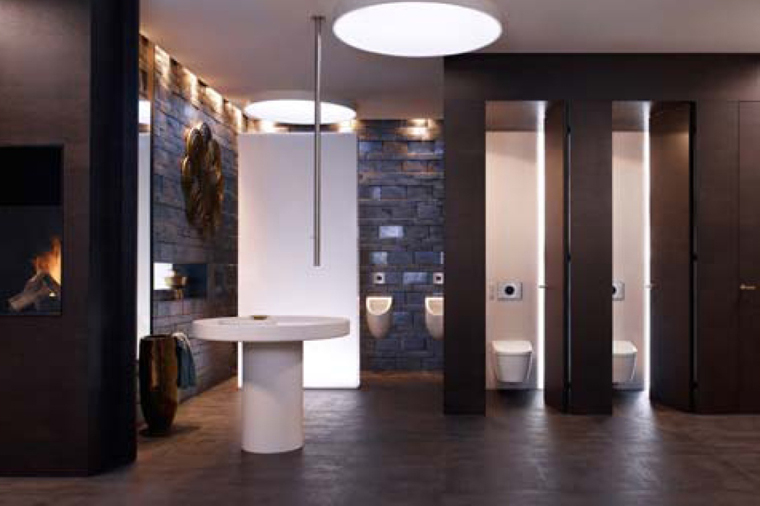Facilities in healthcare institutions such as hospitals must meet the highest hygiene standards. This is because people with a weakened immune system are particularly susceptible to germs and bacteria. There is also a greater risk of infection for hospital staff. Innovative sanitary solutions can help to improve hospital hygiene. They contribute considerably to the health of patients, doctors and nurses. The manufacturers of the Blue Responsibility sustainability initiative know which solutions are particularly suited for use in hospitals.
If you have to stay in hospital, you don’t want to have to worry about additional sources of infection. Optimum hygiene standards are the be-all and end-all. “Bacteria and viruses are quickly passed on, especially via skin contact with contaminated objects, and this can be dangerous for patients with an impaired immune system,” explains Verena Töpfer-König from Franke Aquarotter. This is why it is important to minimise the risk of infection for patients, doctors and nurses by using functional fittings, hygienic substances and products that are easy to clean. At the same time, sanitary products should be long-lasting and particularly sturdy because they are used so much.
Contactless activation for greater hygiene
For almost all elements in the bathroom, the water flow can be activated without touch – from the wash basin taps through to the toilet and urinal flush. Simply swiping the hand is enough to trigger the infra-red controlled flow system, for example. If the infra-red beam is broken by the user’s hand, it reflects it and sends a signal to the magnetic valve to start the water flow. To protect it from misuse, the water is stopped after 40 seconds automatically, even if an objects is placed in the line of the beam. Some solutions even operate fully automatically. The toilet control system by Geberit can, for example, be set so that the flush is triggered automatically after each use. “It uses a particularly reliable distance recognition system,” explains Volker Röttger from Geberit. “The flush is triggered when the person approaches the visible infra-red sensor in the toilet flush panel, i.e. when the user moves away from the toilet.” Urinal flushing systems, for example those by Geberit and Mepa, trigger the flush without touch. The germ risk is therefore considerably reduced.
Hygienic substances don’t give germs a chance
The substances used, in addition to the contactless trigger of the flush, also affect hygiene. Depending on the substance, germs are able to adhere more or less effectively to surfaces. This is why stainless steel was the main material that used to be installed in public areas. Since then, alternatives have been developed that are more pleasant to touch and look at. For example, Franke Aquarotter uses a mineral called miranite – of which 80% is ground marble, sandstone and quartz sand – bound with an artificial resin for its wash basins. The remaining 20% is made from an unsaturated polyester resin. Wrapped in a special layer of gel coating, the material is not only easy to shape and hard to break, but it has no pores. “The material has excellent anti-adhesive qualities thanks to the pore-free surface, so that fewer germs are able take hold on it. This is why it is even used for hand washing in operating theatres,” explains Verena Töpfer-König. At the same time, the material withstands aggressive substances such as disinfectants and can therefore be used to dispose of waste water and for washing cleaning and hospital utensils.
Keramag uses a special glaze that is combined permanently with the ceramic at a temperature of 1,250 degrees. “This makes the surface almost pore-free and much smoother than usual ceramic surfaces. Even powerful cleaning products and high-pressure cleaners cannot damage the glaze,” explains Beate Vetter from Keramag. The glaze is used for wash basins, toilets, urinals and bidets.
Cleaning-friendly product design is kind to the health and to the environment
The shape of a product also has an effect on the extent to which it is cleaning-friendly. If difficult-to-reach areas are avoided in the first place, an important step has been taken towards preventing infection. Rimless toilets fulfil this criterion, as offered by Ideal Standard and Keramag, for example. “By doing away with the rim, all areas are visible and accessible. This means that only a small amount of cleaning product is needed to provide the optimum cleaning result,” explains Gerhard Weber from Ideal Standard. Beate Vetter from Keramag confirms this: “With such products, bacteria, limescale, urine and dirt deposits don’t even get chance to take hold.” Rimless toilets are therefore particularly suited for sensitive areas such as hospitals.
Clever sanitary solutions contribute lastingly to greater health
Thanks to intelligent product design, hygienic substances and avoiding skin contact, the innovative solutions by the German sanitary industry are making a considerable contribution to protecting patients and hospital staff from infections. By using cleaning-friendly materials, less cleaning agent is required, thereby protecting the environment. “Health is our most valuable asset. The German sanitary industry is contributing every day by way of its solutions to protecting our health,” sums up Wolfgang Burchard from Blue Responsibility.
Further details regarding this topic can be obtained on the manufacturers' websites www.franke.com, www.geberit.de, www.idealstandard.de, www.keramag.de and www.mepa.de.
